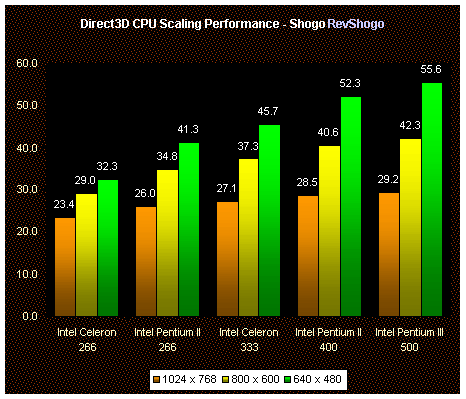Shogo - CPU Scaling Performance

Shogo Performance Conclusions
Since Shogo has yet to support 32-bit color rendering properly, the only two items that could be duplicated in the Direct3D arena were the poor CPU scalability of the Savage4 and its poor performance at higher resolutions. Unfortunately, those two factors being downsides don't really help the argument for the Savage4 under Direct3D.
Direct3D is one of the Savage4's weak points, which is ironic since, at the time, it was one of the Savage3D's strong points. The Savage4 performed well below the rest of the competition in Direct3D, an issue which may or may not be corrected over time with updated drivers. Since the Savage4's silicon is in its final form, the only hope for performance increases now lay with the drivers.
The poor performance of the Savage4 under Direct3D is an unfortunate consequence of the Savage4's low-cost design, however there is hope if your favorite games happen to support S3TC.
Final Words
For those of you expecting the Savage4 to come through as being the world's fastest 2D/3D accelerator, you're out of luck. However, the Savage4 does have its strengths as discussed above. The Savage4's ability to render at 32-bit color depths with a very small loss in performance will make the Savage4 a strong performer in Quake 3 Arena which is supposed to truly illustrate a difference between 16-bit and 32-bit rendering. If it does in fact illustrate such a difference, Savage4 owners will be pleased to know that the drop in performance they'll experience for the added image quality is next to nothing compared to the TNT2 and other competing solutions capable of 32-bit rendering.
S3's use of the texture compression algorithm supported by DirectX 6.1 is an extremely promising tool and if used properly, can improve image quality by an extremely noticeable amount, unfortunately the only question remaining in this case is when S3TC enabled games will actually hit the hands of Savage4 owners. Interplay will be shipping S3TC enhanced versions of Descent 3, and that particular title will probably make its way into a number of software bundles shipping with Savage4 cards, however the big titles such as Quake 3 Arena have yet to illustrate any benefits from S3TC (not a single Q3A S3TC screenshot has been posted). Although we've all seen screenshots from Unreal Tournament, not everyone plays Unreal. For those that don't, implementation of S3TC won't be popular until much later into the year (Q4) when other manufacturers may possibly include support for texture compression.
Should you buy the Savage4? The first thing you need to do is weigh the pros and cons the Savage4 offers you, and then consider the type of system you'll be using. For high-end systems (anything faster than a P2-350/400), the Savage4 shouldn't be your top pick, in spite of its support for texture compression. The target market for the Savage4 are the lower-end CPUs, so if you happen to have a CPU that won't benefit from a TNT2 then the Savage4 may offer the performance you're looking for, even in 32-bit color.
The best way to sum up the Savage4 is this: everything the original Savage3D should have been. Better late than never.










0 Comments
View All Comments